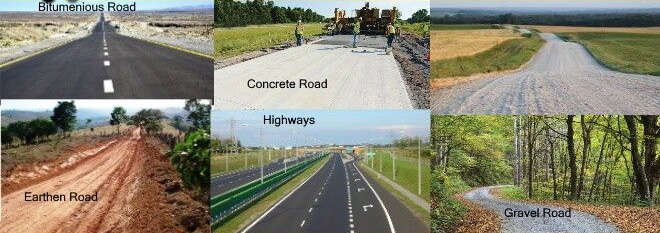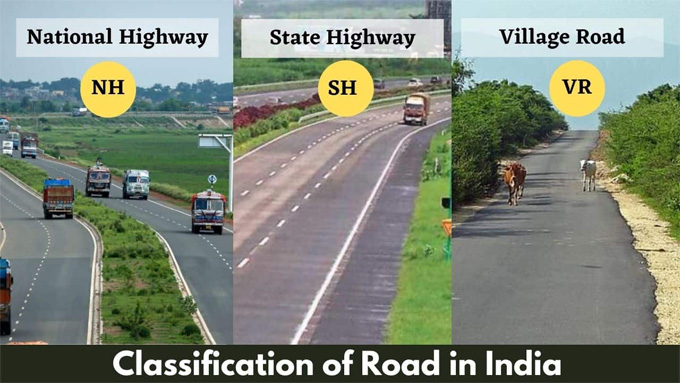
Classification and Types of Roads and Their Details

Different roads have been constructed to achieve smooth communication among different places by allowing the easy transportation process. Roads help to connect cities, states, villages, and countries throughout the world, thus improving the social, cultural, and economic relationships throughout the world.

The construction of the different types of roads has been done on the basis of the rigidity, uses, locations, materials, traffic volumes and other factors. This helps to make the transportation process safer and efficient for people.
Types of roads in civil engineering
The roads have been classified into different categories, which are as follows:
Based on the speed and accessibility
Highways: The fast vehicles can be moved on highways.
Controlled Highways: The ramps control the exit and entry of the vehicles on these types of roads.
Carriageways: The high-volume vehicles can be moved through carriageways.
Roadways: These roads help to connect one state to another.
Based on the construction materials
➢ Earthing roads: The Soil used to make these roads.
➢ Gravel roads: The clay is used in these roads, which is cost-effective.
➢ Asphalt roads: The black glue and thick materials have been produced because of the distillation of petrol in these types of roads.
➢ Concrete roads: Cement concrete materials are used to build these roads.
Based on the economy
Low-Cost Roads: Low-cost materials, including locally available materials, have been used to build these roads.
Medium-Cost Roads: It has better durability than low-cost roads because of uses good-quality materials.
High-Cost Roads: huge capital is required to construct these types of roads, for example, state highways.
Based on the flexibility
Flexible roads: These types of roads have four layers.
Rigid roads: These types of roads have three layers, which makes the roads more flexible.
Based on the traffic
Cycle Roads: Designed for cycling and bikes.
Walkway Roads: Designed for pedestrians.
Motorways: These types of roads are for the free inflow of speed vehicles and business.
Business Roads: Around one thousand vehicles can be moved on this road per day.
Medium Business Roads: Around eight hundred to fifteen hundred vehicles can be moved per day on this road.
High Business Roads: More than three thousand vehicles can be moved per day through these types of roads.
Based on the carriageway
Paved roads: The hard pavement courses, for example, bituminous, WBM, and cement concrete, are used in these roads.
Unpaved roads: No hard pavement is required to construct these roads.
Discuss the importance of classifying roads
➢ The road has been constructed to determine the width lane, the thickness of the pavement and the design speed.
➢ The classification of roads also helps to analyse the traffic load and the structural design of specific places.
➢ The classification of the road is also necessary to decide which construction materials and standards are going to be used in the roads.
➢ The road classification also enables the fund allocation process and systematic planning for the roads.
Classification of Roads in India
The infrastructural development and road connectivity rate are highest in India. There are about 63.73 lakh kilometres of roadways has been made in India, which is the second largest road network in the world. The roads in India have been classified into different categories, which are as follows:
State Highways
The state highways in India help to connect the big cities within the states. In some cases, the state highways have also been connected with the national highways. The state highways of India are known as SH, which is placed before the state code and after the number of the highway. In Maharashtra, Karnataka, Gujarat, Rajasthan, and Tamil Nadu, there are the highest number of state highways in the whole country.
District Roads
The district roads are major roads of the districts in different states of India, which are regularly used by the local residents to go to the marketplace, job place, shopping malls, school, colleges and hospitals. The district road has also been classified into main and minor roads on the basis of their location and uses.
Rural Roads
Around 73% roads in India are rural roads. The Pradhan Mantri Gramme Sadak Yojana was initiated by the Indian government in 2000 to connect the remote rural communities through the rural roads. These rural roads have been built and maintained by the village panchayats of India.
The rural roads of India have also been classified into several types, for example, earthen roads, broder roads, WBM roads, murrum roads and kankar roads. The northern and eastern borders of this country are known as the border roads, which have been maintained by the Border Roads Organisation (BRO) of India.
National Highways
The national highways of India help to connect the important cities of this country, which are identified as NH, followed by the number of the highway. The National Highways Authority of India (NHAI) and the National Highways and Infrastructure Development Corporation Limited (NHIDCL) are involved in building and maintaining the national highways of this country. The national highway has also been classified into several types:
➢ Single-lane highway
➢ Double-lane highway
➢ Four-lane highway
➢ Six-lane highway
➢ Eight-lane highway
Expressways
The expressways are the best quality highways, along with lane dividers, access ramps, elevated parts and grade separation features. In the expressways, there are only certain locations through which cars can enter or exit.
To learn more, watch the following video tutorial.
Video Source: Gurukul of Civil Engineers
The expressways of India have been outfitted with Video Incident Detection System (VIDS) and a Highway Traffic Management System (HTMS), which are environmentally friendly. For four-wheelers, there is a speed limit of about 120 km/h, and for two-wheelers, the speed limit is about 80 km/h on expressways. The Delhi-Mumbai expressway is the longest expressway in India.
International Highways
The international highways of India help to connect this country with the neighbouring countries. For example, the AH-42 helps to connect India with China, AH-43 helps to connect India with Sri Lanka, AH-45 is under planning to connect India with Qatar in the west and Indonesia in the east, and AH-48 helps to connect India with Bangladesh and Bhutan.


